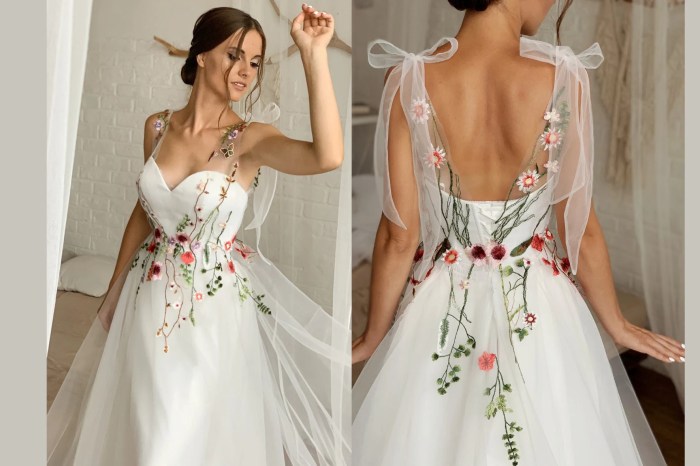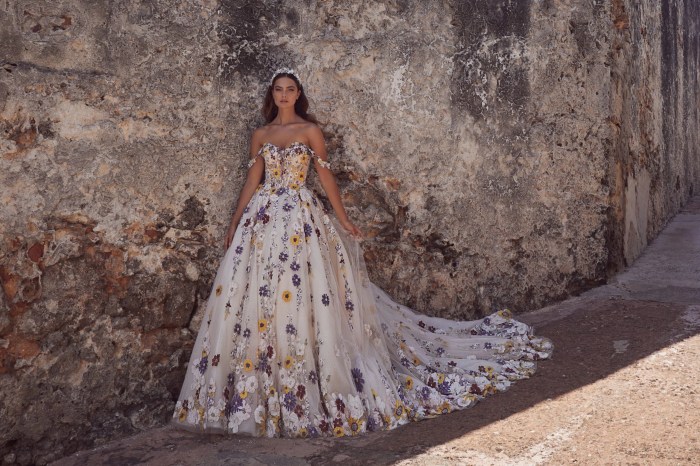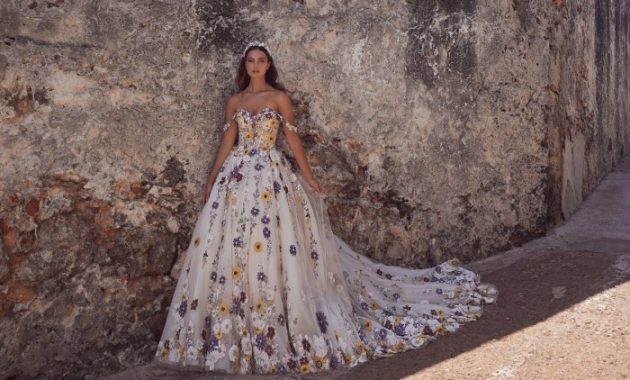Design Elements of a Colourful Embroidered Wedding Dress
The artistry of a colourful embroidered wedding dress lies in the harmonious blend of embroidery style, fabric choice, and colour palette. Careful consideration of each element ensures a breathtaking and unique garment.
Embroidery Styles and Techniques, Colourful embroidered wedding dress
Several embroidery styles lend themselves beautifully to colourful wedding dresses. The choice depends on the desired aesthetic, from delicate floral motifs to bold geometric patterns.
| Embroidery Style | Thread Type | Colour Palette Suggestions | Visual Description |
|---|---|---|---|
| French Knots | Silk, Rayon | Pastels, Jewel Tones | Creates a textured, three-dimensional effect, ideal for floral designs or subtle detailing. |
| Chain Stitch | Metallic, Cotton | Monochromatic, Complementary | Provides a flowing, linear quality, suitable for outlining shapes or creating intricate patterns. |
| Satin Stitch | Silk, Viscose | Analogous, Triadic | Offers a smooth, glossy finish, perfect for filling in large areas of colour or creating bold shapes. |
| Crewel Embroidery | Wool, Cotton | Earthy Tones, Vibrant Accents | Characterized by long, flowing stitches, ideal for depicting landscapes or intricate scenes. |
Fabric Selection for Colourful Embroidery
The fabric chosen significantly impacts the final look and feel of the dress. Certain fabrics complement colourful embroidery better than others.
Lightweight fabrics like silk, chiffon, and organza allow the embroidery to take centre stage, showcasing its intricate details. Heavier fabrics like brocade or velvet provide a luxurious backdrop, adding depth and texture to the embroidery. The drape and flow of the fabric should also be considered, ensuring it complements the overall design.
Colour Palette Choices
Three distinct colour palettes can create dramatically different moods for a colourful embroidered wedding dress.
- Romantic Pastels: Blush pink, lavender, mint green, and ivory create a soft, dreamy aesthetic. This palette is ideal for a spring or summer wedding, evoking feelings of lightness and joy.
- Vibrant Jewel Tones: Ruby red, sapphire blue, emerald green, and amethyst purple create a rich, luxurious feel. This palette is perfect for a fall or winter wedding, conveying a sense of opulence and sophistication.
- Earthy and Natural: Warm browns, muted greens, golden yellows, and creamy whites create a rustic, bohemian feel. This palette is suitable for a countryside or outdoor wedding, emphasizing natural beauty and simplicity.
Cultural and Historical Influences on Embroidery
Embroidery has held significant cultural and historical importance in wedding attire across the globe, often carrying symbolic meaning and reflecting traditions passed down through generations.
Historical Significance of Embroidery in Wedding Attire

Source: etsystatic.com
From ancient times, embroidery has adorned bridal garments, signifying wealth, status, and good fortune. In many cultures, intricate embroidery was a testament to the bride’s skill and dedication, representing the care and effort she would bring to her new life. The designs themselves often carried symbolic meanings related to fertility, prosperity, and longevity.
Comparative Analysis of Embroidery Styles
Embroidery styles vary significantly across different cultures, each with unique characteristics.
- Indian Embroidery: Known for its intricate detail, vibrant colours, and use of metallic threads. Common stitches include chain stitch, satin stitch, and French knots. Designs often incorporate floral motifs, paisley patterns, and religious symbols.
- Chinese Embroidery: Characterized by its fine stitches, precise lines, and use of silk threads. Designs often depict auspicious symbols, such as dragons, phoenixes, and peonies, representing good luck and prosperity.
- Mexican Embroidery: Often features bold colours, geometric patterns, and floral designs. Traditional stitches include cross-stitch, backstitch, and running stitch. The embroidery often reflects regional variations and indigenous influences.
Symbolism in Colour and Embroidery Patterns
Colours and patterns in wedding embroidery often hold symbolic meanings. For example, red is frequently associated with good fortune and prosperity in many Asian cultures, while white represents purity and innocence in Western traditions. Floral motifs often symbolize fertility and new beginnings, while geometric patterns can represent stability and order.
Modern Interpretations of Colourful Embroidered Wedding Dresses
Contemporary designers are reimagining traditional embroidery techniques, incorporating modern aesthetics and innovative materials to create stunning and unique wedding dresses.
Modern Design Sketches
- Bohemian Rhapsody: A flowing A-line silhouette in ivory silk chiffon, adorned with colourful floral embroidery in shades of blush pink, lavender, and gold. The embroidery features a mix of French knots and chain stitch, creating a textured and romantic look.
- Geometric Grace: A sleek sheath dress in blush pink crepe, featuring bold geometric embroidery in shades of emerald green, sapphire blue, and ruby red. The embroidery utilizes satin stitch and cross-stitch, creating a modern and sophisticated aesthetic.
- Rustic Romance: A relaxed fit-and-flare dress in ivory linen, embellished with delicate floral embroidery in muted greens, browns, and creams. The embroidery employs crewel stitch and running stitch, creating a rustic and charming feel.
Current Fashion Trends
Current bridal fashion trends incorporate elements such as sustainable materials, vintage-inspired details, and minimalist designs. These trends can be seamlessly integrated into a colourful embroidered wedding dress, creating a unique and contemporary piece.
Modern Designers and Their Work
- Designer A: Known for their use of intricate hand-embroidered details on flowing silhouettes, often incorporating bold colour palettes and unexpected textures.
- Designer B: Celebrated for their minimalist aesthetic, using subtle embroidery to enhance the clean lines of their designs. They often favour muted colour palettes and natural fabrics.
- Designer C: Famous for their innovative approach to embroidery, incorporating unconventional materials and techniques to create truly unique and eye-catching wedding dresses.
The Process of Creating a Colourful Embroidered Wedding Dress
Designing and creating a custom embroidered wedding dress is a meticulous process requiring careful planning and execution.
Steps in the Design and Creation Process
- Initial Consultation: Discuss the bride’s vision, including desired style, colour palette, and embroidery details.
- Sketching and Design Development: Create sketches and detailed drawings of the dress design, including embroidery placement and patterns.
- Fabric Selection: Choose fabrics that complement the embroidery style and colour palette.
- Thread Selection: Select embroidery threads that match the desired colours and textures.
- Embroidery Creation: Execute the embroidery using appropriate techniques and stitches.
- Dress Construction: Construct the dress, incorporating the embroidered panels.
- Final Adjustments and Finishing: Make any necessary alterations and complete final finishing touches.
Thread and Fabric Selection

Source: kleinfeldbridal.com
The selection of threads and fabrics is crucial to achieving the desired visual effect. High-quality threads ensure longevity and vibrancy of the embroidery, while the fabric choice determines the drape, texture, and overall feel of the dress.
Embroidery Techniques
Various embroidery techniques can be used, each with its unique characteristics. French knots create a textured effect, satin stitch provides a smooth finish, and chain stitch offers a flowing line. The choice of technique depends on the desired design and overall aesthetic.
Visual Representation and Inspiration: Colourful Embroidered Wedding Dress
Visual aids are essential in showcasing the potential beauty of a colourful embroidered wedding dress and inspiring design choices.
Detailed Visual Descriptions
- Dress 1: A flowing A-line gown in ivory silk organza, adorned with vibrant floral embroidery in shades of ruby red, sapphire blue, and emerald green. The embroidery utilizes a combination of French knots, satin stitch, and chain stitch, creating a three-dimensional effect. The dress features a delicate lace trim at the neckline and sleeves, adding a touch of elegance.
- Dress 2: A fitted sheath dress in blush pink crepe, embellished with intricate geometric embroidery in shades of gold, silver, and ivory. The embroidery uses a combination of satin stitch and cross-stitch, creating a modern and sophisticated look. The dress features a high neckline and a subtle train, adding a touch of drama.
- Dress 3: A relaxed fit-and-flare gown in ivory linen, adorned with delicate floral embroidery in muted shades of greens, browns, and creams. The embroidery employs a combination of crewel stitch and running stitch, creating a rustic and charming aesthetic. The dress features a low back and a flowing skirt, adding a touch of bohemian flair.
Impact of Lighting Conditions
Lighting significantly affects the appearance of a colourful embroidered wedding dress. Natural daylight enhances the vibrancy of the colours, while artificial lighting can alter the hues and create different moods. Consider the lighting conditions during the wedding ceremony and reception when selecting the colour palette and embroidery design.
Mood Board Creation
A mood board can be created using images of fabrics, embroidery samples, colour palettes, and inspirational images to guide the design process. This visual representation helps to solidify the overall aesthetic and ensure consistency throughout the design.
Answers to Common Questions
How much does a custom colourful embroidered wedding dress cost?
The cost varies greatly depending on the complexity of the design, the type of fabrics and embroidery threads used, and the designer’s fees. Expect a significant investment compared to a standard wedding dress.
How long does it take to create a custom embroidered wedding dress?
The creation process can take several months, even up to a year, depending on the intricacy of the embroidery and the designer’s workload. Early planning is crucial.
Can I incorporate family heirlooms into the design?
Absolutely! Many designers welcome the incorporation of family heirlooms, such as lace, buttons, or even existing embroidery, to add a sentimental touch and unique character to the dress.
How do I care for a colourful embroidered wedding dress after the wedding?
Professional dry cleaning is recommended to preserve the embroidery and fabric. Avoid harsh chemicals and store the dress in a breathable garment bag to prevent damage.

